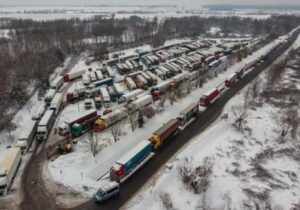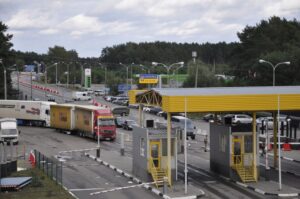
The Polish government is making efforts to effectively represent the interests of Polish carriers and drivers, which will lead to a weakening and, as a result, an end to the blockade on the Polish-Ukrainian border, Polish Prime Minister Donald Tusk said on Wednesday at a press conference after a government meeting.
“I don’t think we will achieve the maximum demanded by the Polish protesting carriers, but it seems that what can be achieved will allow us to defuse emotions and perhaps quickly lift the blockade on the border. I think we are close to believing that our actions can bring results – both actions in Kyiv and negotiations in Brussels,” he was quoted as saying by polskieradio24.pl.
Tusk also said that after the government meeting, a meeting of the Security Committee of the Council of Ministers was held, during which Foreign Minister Radoslaw Sikorski reported on his visit to Kyiv.
“It confirmed what we all know and feel, that the situation at the front is difficult,” the Prime Minister said.
He noted that “in general, the situation in Ukraine is quite dramatic for various reasons. This requires us to be very active, both in terms of diplomatic and political support, as well as strong cooperation in terms of material assistance to Ukraine,” Tusk emphasized.
As reported, Polish carriers began blockading the Yahodyn-Dorohusk, Krakovets-Korchova and Rava-Ruska-Krebenne checkpoints on November 6, and on November 22, the Oszukana Wieś organization joined the protest and blocked the Shehyni-Medyka checkpoint. Only the checkpoints for empty vehicles and those for light trucks remained outside the blockade.
On December 11 at 14:00 Kyiv time, the head of the Dorohuska Commune dissolved the protest of Polish carriers, and later refused to satisfy a new protest application. However, on December 15, a local Polish court overturned this decision, allowing the protesters to resume the blockade on December 18.
The organizers of the blockade, who demand the abolition of the “transport visa-free regime” for Ukraine introduced with the war, reported that, according to the official permission of the local authorities, it would last until January 3, 2024. However, some checkpoints already have permits to extend it until February, and a new blockade of the Dorohusk-Yagodyn checkpoint, according to Polish media, has been announced until March. The Ukrainian side had hoped for the border to be unblocked after the new government led by Donald Tusk came to power in Poland in mid-December, but so far, the blockade has been lifted only at the Shehyni-Medica checkpoint since December 25.

More than two thousand trucks are standing in line at three directions of the Ukrainian-Polish border due to the ongoing blockade organized by Polish carriers, the spokesman for the State Border Guard Service of Ukraine, Andriy Demchenko, said on a national telethon on Sunday morning.
“Three directions remain blocked: Rava-Ruska – Hrebenne, Krakovets – Korchova, Shehyni-Medyka… As of this morning, there are about 2,150 trucks in the queues in these three directions heading to Ukraine in Poland. Most of them are in front of Shehynia-Medica. There is traffic, but it is not as intense as it was before November 6 or November 23, when the blocking of Shehynia began,” the spokesman said.
At the same time, Demchenko emphasized that the Yahodyn-Dorohusk direction, which was unblocked on December 11, is experiencing heavy traffic of freight transport.
“Over the past day, about 1,500 trucks crossed this direction in both directions. Most of them were heading towards Ukraine. This is a very high rate of border crossing. Because the same number of trucks, even less, crossed the border before the blockade,” said the spokesman.

According to information received by Ukrainian border guards on the evening of December 14, representatives of Slovak carriers unblocked truck traffic entering Slovakia at the Vysne Nemecke checkpoint for an indefinite period of time, the State Border Guard Service of Ukraine reported on its Telegram channel.
“Since the end of the blockade, as of 09:00 on December 15, almost 60 trucks have been cleared to leave Ukraine through the Uzhhorod checkpoint, and another 1065 are in the electronic queue to leave Ukraine,” the statement said.
As reported, on December 11, Polish carriers ended the blockade in front of the Dorohusk-Yahodyn checkpoint.
The Union of Road Carriers of Slovakia (UNAS) blocked truck traffic through the only border checkpoint with Ukraine, Vysne Nemecke-Uzhhorod, from 15:00 on December 11.

As of Sunday morning, December 10, about 3,500 trucks are queuing to enter Ukraine at the Ukrainian-Polish border, according to the spokesman for the State Border Guard Service of Ukraine (SBGS), Andriy Demchenko.
“The situation is almost unchanged. Four directions are blocked. “Rava-Ruska – Khrebenne, Yahodyn – Dorohusk, Krakovets – Korchova, Shehyny – Medyka. As of this morning, according to the information we have from the Polish border guards, almost 3,500 trucks are in line to cross into Ukraine,” Demchenko said on the air of the national telethon on Sunday.
The SBGS spokesman noted that the largest number of trucks is opposite the Shehyni checkpoint – 1,200, and the Yahodyn checkpoint – almost 900.
“Of course, during the day there is a certain movement of trucks both entering Ukraine and leaving Ukraine in the direction of Poland, but there is no dynamics and intensity that was before November 6,” added Demchenko.

The Union of Slovak Carriers plans to block the movement of freight transport in front of the Vysne Nemecke checkpoint adjacent to the Ukrainian checkpoint Uzhhorod from 16:00 on December 1, 2023, the State Border Guard Service of Ukraine reports.
“Four trucks per hour will be allowed to leave Slovakia. At the same time, the transportation of humanitarian and military aid, live animals, fuel and refrigerated cargo will not be blocked,” the message on the Telegram channel reads.
Drivers are asked to take into account possible traffic complications.

The Union of Dairy Enterprises of Ukraine (UDEP) and the Polish Dairy Chamber call on the governments of both countries to create conditions that would make it impossible to block the Ukrainian-Polish border.
“At a time when Ukraine is forming an outpost on the eastern borders of the European Union to expand the principles of democracy and free market, including with the active support of Poland, the governments of both countries should take the initiative and responsibility for creating conditions that would make such destructive situations impossible. If such situations do arise, the governments should promptly take the necessary measures to resolve them,” the dairy associations said in a statement published on the UMCU website on Wednesday.
According to the dairy associations, the blocking of transport at the border by some Polish organizations jeopardizes full-fledged trade relations between Ukraine and Poland.
The UMCU and the Polish Dairy Chamber emphasized the inadmissibility of extreme measures: if they become systemic, they pose a threat to the development of Ukrainian and Polish companies.
The appeal cites data from the State Customs Service of Ukraine, according to which in January-October 2023, Poland exported almost EUR 5.5 billion worth of goods to Ukraine, including EUR 160 million worth of dairy products.
Maintaining full-fledged trade relations between Ukraine and Poland is equally important for entrepreneurs in both countries, the dairy associations of Ukraine and Poland summarized.
According to Andriy Demchenko, a spokesman for the State Border Guard Service of Ukraine, as of the morning of November 22, there were about 2,700 trucks on the Ukrainian-Polish border at three checkpoints – Yagodyn-Dorogusk, Krakovets-Korchova, and Rava-Ruska-Krebenne.